The Plenary Council 2020/21 is an opportunity for the Catholic Church in Australia to refocus on its primary mission which is that of evangelisation. The heart of evangelisation is the proclamation of Jesus Christ as Lord and Saviour: “And there is salvation in no one else, for there is no other name under heaven given among men by which we must be saved” (Acts 4:12).
To ensure the Plenary Council bears good fruit in the life of the Church in Australia, we should take note of a letter addressed by Pope Francis to “the People of God” in Germany on June 29, 2019. Here the Holy Father expressed support for a Synodal Assembly of the Church in Germany, while at the same time sounding a note of caution. He said the synod would be fruitful if it relied on the guidance of the Holy Spirit and was based on prayer, fasting and openness to pastoral conversion. He stated that concern for evangelisation had to be the primary objective of the synod, something which he said begins by the Church first “evangelising itself” (n. 7).
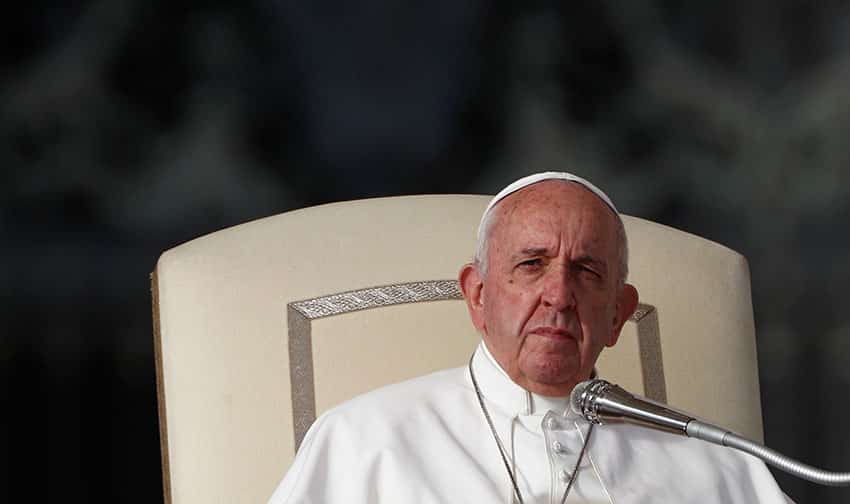
Referring to “temptations” to be avoided in the synodal process, Pope Francis said: “Every time an ecclesial community has tried to get out of its problems alone, relying solely on its own strengths, methods and intelligence, it has ended up multiplying and nurturing the evils it wanted to overcome” (n. 6). After saying he had taken painful notice of how there had occurred in Germany a “growing erosion and deterioration of faith with all it entails not only on the spiritual level but also on the social and cultural level” (n. 2), Pope Francis went on to warn that attempts at false reform could cause the Church in Germany to sever its ties with the Universal Church in consequence of which it would “weaken, corrupt and die” (n. 9).
Though a Synodal Assembly is different to a Plenary Council in terms of its mode of operation and legislative powers, there are similarities nevertheless. As is the case with Germany’s Synodal Assembly, so too will Australia’s Plenary Council be counter-productive if it makes recommendations for Church reform that are in contradiction to the Church’s sacramental and moral doctrine.
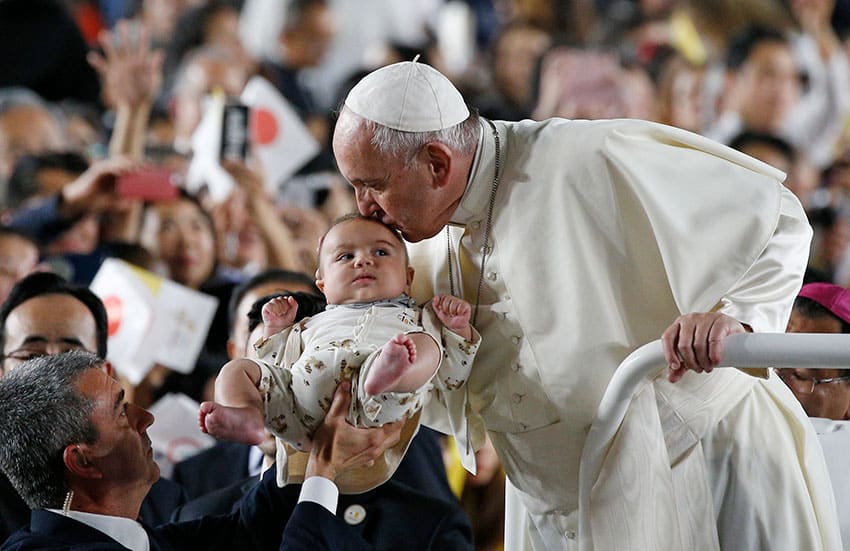
While the Plenary Council has no authority to change the Church’s doctrine, there are however individuals and groups urging it to petition the Holy See to consider making changes in doctrinal teachings of the Church along lines that contradict what up to now has been transmitted as part of the essential content of the doctrines in question. This violates one of the principles underlying authentic doctrinal development. When this is allowed go unrefuted, it becomes a form of scandal in that it can lead members of the faithful away from the truth.
Getting Back On Mission: a corruption of Catholic Doctrine?
On 17 September 2019, a book produced by an organisation called Catholics For Renewal and titled ‘Getting Back On Mission: Reforming Our Church Together’ (GBOM hereafter), was launched at Melbourne University’s Newman College. The book doubles up as a submission to Plenary Council 2020/21, urging it to lobby the Holy See to make changes to definitive Catholic teaching along lines that if approved would represent a corruption of the Church’s doctrine. In reality this could never happen, since God himself through the Sacred Magisterium of the Church, protects the integrity of the essential content of the Church’s doctrine in the course of its transmission across time. In the meantime however, public campaigns for such impossible-to-realise changes in Church teaching undermines its missionary thrust.
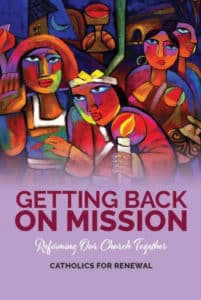
Though GBOM contains many obfuscations and contradictions of Catholic doctrine, it nevertheless carries strong endorsements from high-profile Catholics, something that adds to the book’s potential to spread error in the body of the faithful. The endorsees include Mary McAleese, former President of Ireland and current Chancellor of Trinity College Dublin, as well as Emeritus Professor John Warhurst AO, Member of the Australian Bishops’ Church Governance Review Panel. Also endorsing the book is Fr Frank Brennan SJ, AO who earlier this year resigned as CEO of Catholic Social Services Australia and is scheduled to take up the role of Rector of Newman College in 2020. In his endorsement of GBOM, Fr. Brennan says: “In Getting Back on Mission, Catholics for Renewal have provided a realistic, hopeful and authentically Catholic roadmap for the forthcoming Australian Plenary Council”.
Fr Brennan’s categorisation of GBOM as “authentically Catholic” makes no sense at all. The book erroneously asserts (cf. pp. 183-184) that rejection of Pope St. Paul VI’s teaching in Humanae Vitae on the integral nature of marital love and its relationship to human procreation and responsible parenthood is an expression of the sensus fidei. This latter term, often understood as synonymous with the related term sensus fidelium, refers to what is known as “the supernatural sense of the faith,” something possessed by the whole body of the faithful, and by individual members of the Church to the extent that what they hold to be true is in harmony with the teaching of the Magisterium (teaching authority of the Church).
Faulty logic?
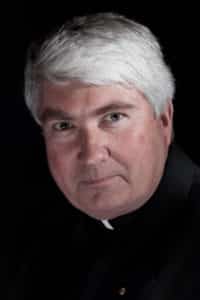
GBOM takes up the question of the moral nature of homosexual acts by critiquing the teaching of the Catechism of the Catholic Church (CCC hereafter). In doing so it draws a false dichotomy between what the CCC teaches on the objectively disordered nature of homosexual acts and its teaching that people with a homosexual inclinations “must be accepted with respect, compassion, and sensitivity” and that “every sign of unjust discrimination in their regard should be avoided” (cf. GBOM pp. 99-100, citing CCC 2357-59). As a logical development of its failure to accept that respect for persons is not incompatible with affirming the existence of intrinsically evil acts, which includes acts against the virtue of chastity such as homosexual practices, GBOM goes on to say: “We recommend that these provisions in the Catholic Catechism be reviewed urgently in light of modern understanding of God-given human sexuality” (p. 100).
After stating that in the November 2017 Australian Marriage Law Postal Survey “many of the faithful” rejected the Commonwealth’s earlier definition “of marriage as a union between a man and a woman” so as to favour a change in the Marriage Act “to marriage being a union between two people,” GBOM goes on to add that this suggests that “the ‘susceptibilities’ of Catholics on marriage equality and traditional attitudes to LGBITQ+ persons had changed markedly.” In light of this, it says: “The Plenary Council cannot honestly avoid asking itself whether the rejection by a significant number of the faithful of this, and of other teachings of the Church on sexual morality and marriage, is not an expression of the sensus fidelium on the signs of the times” (p. 184).
The Ordination of Women
In many and varied ways, GBOM attacks received Catholic doctrine on the origin and nature of the ministerial (ordained) priesthood. Due to limitation of space, I will confine my comments here to what it says about the question of the Church’s reservation of the ordained priesthood to men alone. This question has come up a lot in the preparatory phases for the Plenary Council held up to now.
GBOM says: “The ordination of women is one of several ways the Church could ameliorate structural inequality” (p. 131). It adds that “the Church could redress the failure to include women in governance mechanisms” by “the ordination of women to the priesthood” (p. 132). Then, in castigating the Church for its teaching on the reservation of priestly ordination to men alone, it says:
“The Church’s own tradition does not support the teaching that women are incapable of being validly ordained. The exclusion of women from the priesthood has no foundation in scripture; this is a man-made construct where patriarchy is assumed to be the unassailable ‘norm’, a view so blinkered it fails to give credence to any other perspective as the defining characteristic of a dominant hegemony. The Church must scrutinise the signs of the times and see the recognition of women’s rights throughout the entire secular world as a sign to the Church that it must revise this ban on women’s ordination” (p. 132).
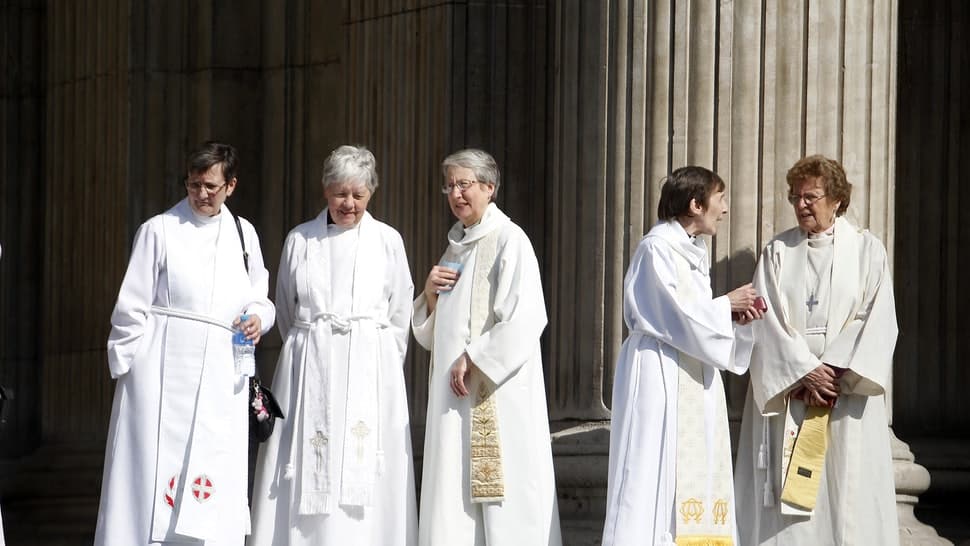
GBOM goes on to recommend “that the Holy See commit to gender balance in the leadership of the Church at all levels,” and that it “take note of the sensus fidei fidelium in Australia with regard to the ordination of women to the priesthood and to the diaconate; and that it review the Church’s position regarding women and the sacrament of Holy orders, commencing with the Order of Diaconate” (p. 142).
GBOM claims that there is no consistent tradition in the Church prohibiting the ordination of women to the priesthood. After stating that “since the church hierarchy is entrusted with the sacramental economy, it may be that the hierarchy is able to entrust the ministries of Eucharist and Reconciliation to women in light of circumstances, without going against Christ’s original intentions,” it goes on to add: “In fact, this is what happened during the Communist era in Czechoslovakia (1948-1989), when four women were validly and lawfully ordained to the priesthood” (p. 175).
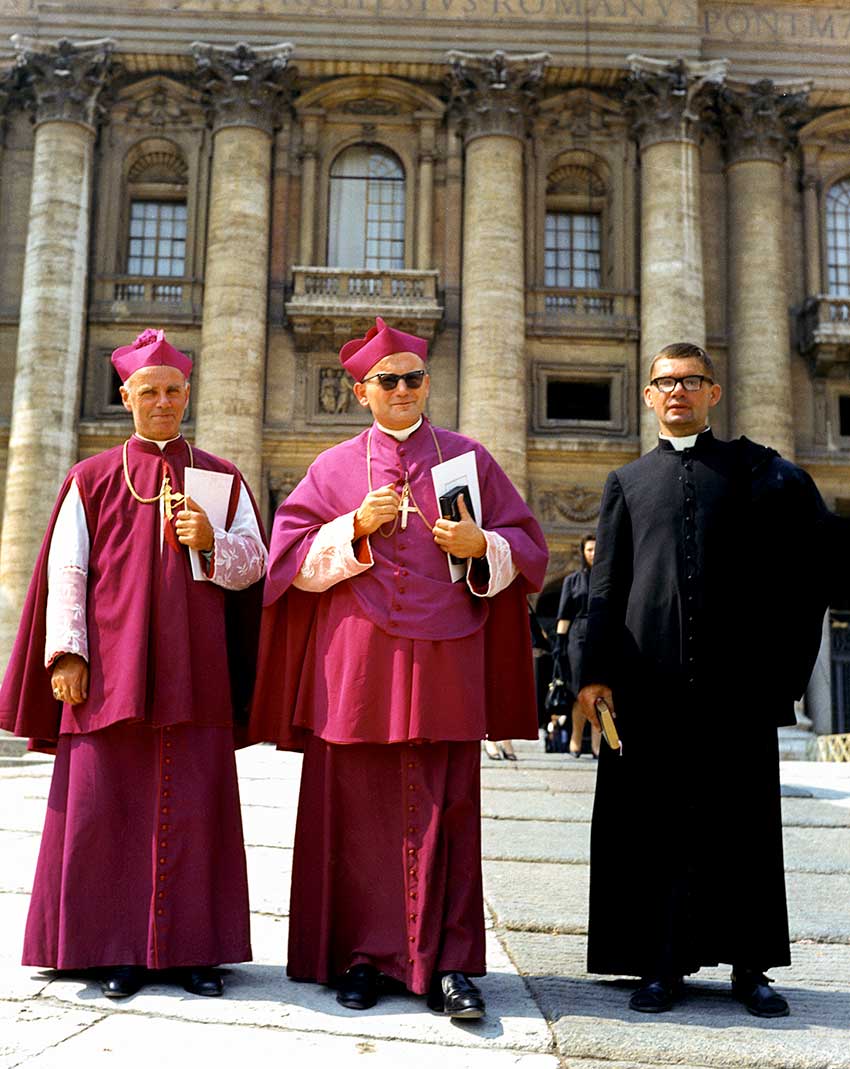
It has never been the case anywhere in the world that a woman has been validly ordained to the ministerial priesthood in the Catholic Church. Further to this, GBOM’s assertions that there is no foundation in Sacred Scripture or support in the Church’s tradition for its practice of not conferring the ordained priesthood on women are both false.
Demand for women’s ordination to the priesthood made its appearance within heretical sects in the early centuries of the Christian era. It appeared notably among gnostic sects, who attempted to confer a form of ministerial priesthood on women by allowing them to “preside” over so-called “eucharistic” celebrations. St Irenaeus identified the practice with Valentinian gnosticism.[1]
“Demand for women’s ordination … in the early centuries of the Church’s existence … appeared notably among gnostic sects.”
Whenever the question of ordaining women to the priesthood was raised in the first millennium of the Church’s history, it was rejected not simply as contrary to established discipline, but as heresy. There are references to this in the writings of Tertullian (d. 220), St. Epiphanius of Salamis (d. 403), St. Augustine (d. 430) and St. John Damascene (d. 749). Speaking of attempts to confer the ministerial priesthood on women, Fr. Louis Ligier, S.J. said: “It is united with the corrupted eschatology and pneumatology of Montanism. It is met with, furthermore, in the corrupted Marian cult of the Coliridians.” He added: “Such a heretical milieu was in itself and still remains for us today, a sign of a considerable alienation from the genuine Christian tradition.”[2]
Founded on the example of Jesus
In his 1994 Apostolic Letter Ordinatio Sacerdotalis, St. Pope John Paul II stated that the practice of not conferring priestly ordination on women was founded on the example of Christ as recorded in the Gospels and on the universal Tradition of the Church. In consequence of this, he declared that “the Church has no authority whatsoever to confer priestly ordination on women and that this judgement is to be definitively held by all the Church’s faithful” (n. 4).
In October 1995, the Congregation for the Doctrine of the Faith (CDF), issued with the approval of St. John Paul II, a theological note regarding the teaching of Ordinatio Sacerdotalis which said: “This teaching requires definitive assent, since, founded on the written word of God and from the beginning constantly preserved and applied in the Tradition of the Church, it has been set forth infallibly by the ordinary and universal Magisterium.”[3]
Church practice on priesthood reaffirmed
In 1998, Pope John Paul II issued Ad tuendam fidem (To Defend the Faith) promulgating changes to Canon Law which he said were necessary to protect the faith of the Catholic Church against errors emanating from dissident theologians. On 20 November 1999, in an address to German bishops, he referred to the Church’s teaching on the reservation of the ordained priesthood to men by saying: “[T]he doctrine that the priesthood is reserved to men, possesses by virtue of the Church’s ordinary and universal magisterium, the character of infallibility which Lumen gentium speaks of and to which I gave juridical form in the Motu Proprio Ad tuendam fidem.”
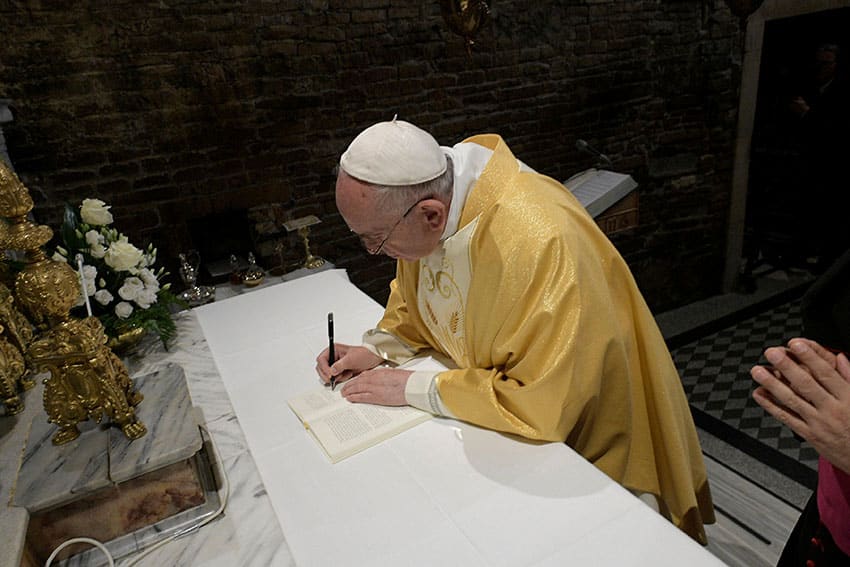
Pope Benedict XVI reaffirmed the teaching on the reservation of priestly ordination to men when he said that Pope John Paul II had “declared in an irrevocable manner” that the Church “has received no authority from the Lord” to ordain women.[4] Similarly did Pope Francis reaffirm the doctrine in his Apostolic exhortation Evangelii Gaudium when he said: “The reservation of the priesthood to males, as a sign of Christ the Spouse who gives himself in the Eucharist, is not a question open to discussion…” (n.104). He returned to the topic during a Press Conference on board his return flight from an Apostolic trip to Sweden on November 1, 2016 when in response to a question on the matter he said: “On the ordination of women in the Catholic Church, the last word was clearly given by Saint John Paul II, and this remains.”
Teaching not based on the evolution of history
The Catholic Church’s teaching on the reservation of priestly ordination to men does not depend on evolving historical consciousness and social circumstances as is sometimes asserted. Those in the Church who continue to assert that the teaching is not definitive spark fractious arguments amongst the body of the faithful over something impossible to realise in the concrete, i.e. the priestly ordination of women.
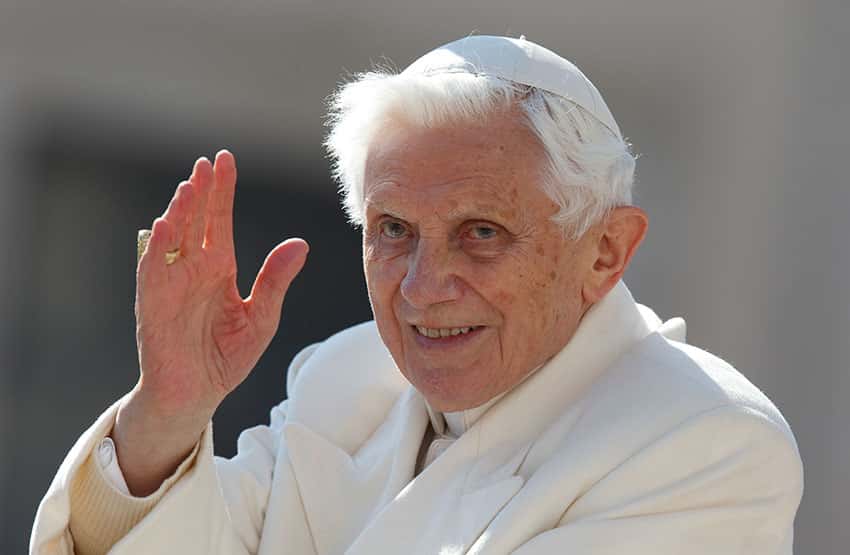
The unity of the Catholic Church is rooted in the celebration of the Eucharistic Sacrifice of the Mass, which according to Vatican II, is the “source and summit of the Christian life.”[5] Only a validly ordained priest can consecrate the bread and wine so that they become the Body, Blood, Soul and Divinity of our Lord Jesus Christ. Referring to this, St John Paul II said: “For priests, as ministers of sacred things, are first and foremost ministers of the sacrifice of the Mass. The role is utterly irreplaceable, because without the priest there can be no eucharistic offering.”[6]

Since the Catholic Church teaches definitively that only men can be ordained to the priesthood, then to assert that it is wrong on this point is to call into question not only what it teaches about the essential elements for the valid celebration of the sacrament of Holy Orders, but also what it teaches as one of the essential elements for a valid celebration of the Eucharistic Sacrifice itself. If the Catholic Church could be wrong on this question, then why should its teaching in any area be trusted?
Conclusion
An authentic exercise of the sensus fidelium can never entail taking an oppositional stance to definitive Church teaching such as that which holds that homosexual acts are always intrinsically evil and never to be chosen. The same principle applies to contraceptive acts, whereby a married couple intentionally seek to render the marital act infertile. Neither can the sensus fidelium find expression in opposition to the Church’s teaching on the reservation of the ordained priesthood to men alone. To assert anything to the contrary is to place oneself in opposition to the binding doctrine of the Catholic Church.
Related:
Footnotes
[1] Cf. St. Irenaeus, Adversus Haereses, 1,13,2.
[2] Fr Louis Ligier, S.J., L’Osservatore Romano, 2/3/78.
[3] Response of CDF to the ‘Dubium’, L’Osservatore Romano, November, 22, 1995)
[4] Pope Benedict XVI, Chrism Mass, April 5, 2012
[5] Vatican II, Lumen Gentium, n. 11
[6] St. John Paul II, Pastores Dabo Vobis, n.48.
